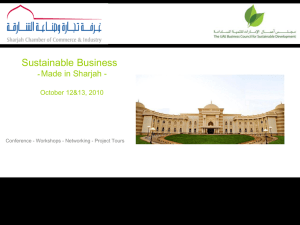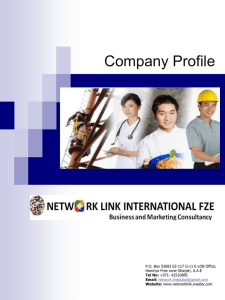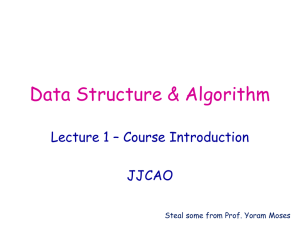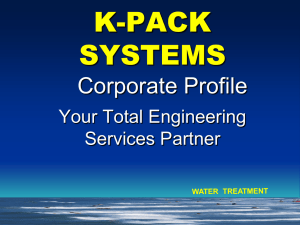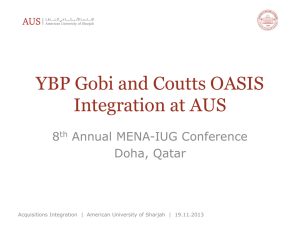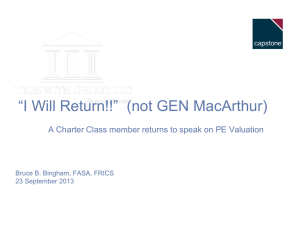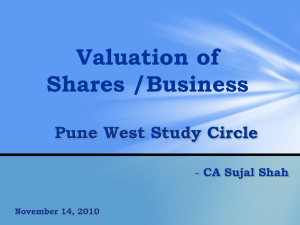Quantitative Methods in Companies* Valuation
advertisement
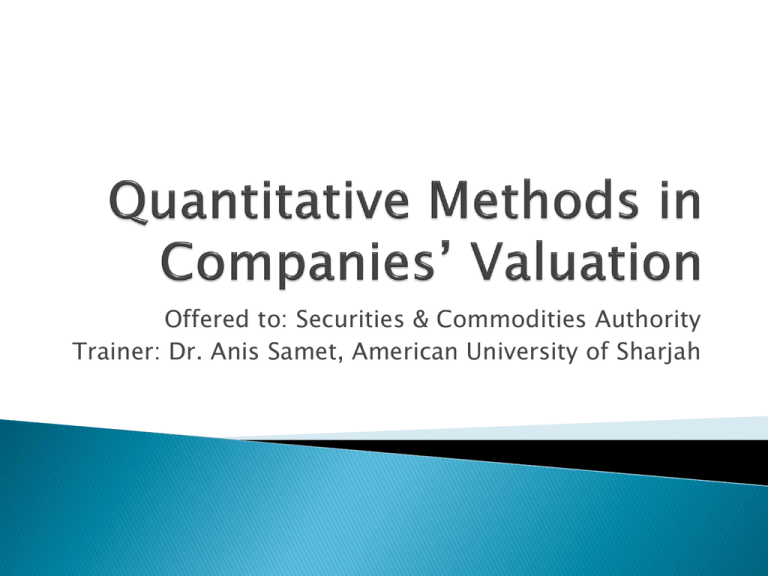
Offered to: Securities & Commodities Authority Trainer: Dr. Anis Samet, American University of Sharjah Day 1 1. Workshop pre-assessment (5 mn.) 2. Session 1: Introduction to values (90 mn) 3. Session 2: Discounted cash flow 1(135 mn) 4. Session 3: Discounted cash flow 2 (60 mn) 5. Day-1-assessment (10 mn) 6. Case study, part 1 (45 mn) Day 2 1. Session 1: Multiples 1 (90 mn) 2. Session 2: Multiples 2 (135 mn) 3. Alternatives and latest methodologies (60 mn) 4. Final-assessment (5 mn) 5. Case study, part 2 (45 mn) Anis Samet, Ph.D., American University of Sharjah 2 Day 1 Anis Samet, Ph.D., American University of Sharjah 3 Please answer the pre-assessment questions! Anis Samet, Ph.D., American University of Sharjah 4 Financial Statements: A review Anis Samet, Ph.D., American University of Sharjah 5 Balance sheetالميزانية العمومية ) Asset (balance sheetأصل/موجودة(الميزانية العمومية) Equityحقوق الملكية/استثمار رأس المال Liabilitiesمطلوبات /خصوم /التزامات /ديون ) Income statement (USبيان /قائمة الدخل Revenuesاإليرادات Expenseمصروف Cash flow statementبيان /قائمة التدفق النقدي Cash inflowالتدفق النقدي الوارد (النقد الوارد /المقبوض) Cash outflowالنقد الصادر /المدفوع Consolidated financial statementبيانات /قوائم مالية موحدة /مدمجة Financial statementsالقوائم المالية Note to financial statementsمالحظات (إيضاحات) ملحقة بالقوائم المالية Shareholder’s capital, shareholder’sرأس مال المساهمين ،حقوق ملكية equityالمساهمين ) Initial Public Offerings (IPOالكتتاب العام 6 Anis Samet, Ph.D., American University of Sharjah Businesses report information in the form of financial statements issued on a periodic basis. GAAP requires the following four financial statements: 1. Balance Sheet - statement of financial position at a given point in time 2. Income Statement - revenues minus expenses for a given time period 3. Statement of Owner's Equity - also known as Statement of Retained Earnings or Equity Statement 4. Statement of Cash Flows - summarizes sources and uses of cash Anis Samet, Ph.D., American University of Sharjah 7 The balance sheet is based on the following fundamental accounting model: Assets = Liabilities + Equity Assets can be classed as either current assets or fixed assets. Liabilities (current & long term) represent the portion of a firm's assets that are owed to creditors Equity is referred to as owner's equity in a sole proprietorship or a partnership, and stockholders' equity or shareholders' equity in a corporation Anis Samet, Ph.D., American University of Sharjah 8 Anis Samet, Ph.D., American University of Sharjah 9 The income statement presents the results of the entity's operations during a period of time Net Income = Revenue - Expenses Revenue refers to inflows from the delivery of a product/service and expenses are outflows incurred to produce revenue Anis Samet, Ph.D., American University of Sharjah 10 Anis Samet, Ph.D., American University of Sharjah 11 The equity statement explains the changes in retained earnings. The statement of retained earnings uses information from the Income Statement and provides information to the Balance Sheet The following equation describes the equity statement for a sole proprietorship: Ending Equity = Beginning Equity + Investments - (Withdrawals/Paid Dividends) + Income Anis Samet, Ph.D., American University of Sharjah 12 The statement of cash flows is useful in evaluating a company's ability to pay its bills. For a given period, the cash flow statement provides the following information: Sources of cash Uses of cash Change in cash balance The cash flow statement breaks the sources and uses of cash into the following categories: 1. Operating activities 2. Investing activities 3. Financing activities Anis Samet, Ph.D., American University of Sharjah 13 Anis Samet, Ph.D., American University of Sharjah 14 Refer to the financial statements of Tabreed in Arabic and English Arabic English Anis Samet, Ph.D., American University of Sharjah 15 Session 1: Introduction to Values Anis Samet, Ph.D., American University of Sharjah 16 Valuation may be done by the seller prior to entertaining prospective buyers, by the buyer who identifies a specific target or by both parties during negotiations to resolve a dispute over price Company valuation is not an exact science. There are numerous acceptable valuation methods and, in most situations, each will yield a different result The formal mathematical valuation should only play one part in the overall pricing of the deal and in determining the transaction's true value to the parties Anis Samet, Ph.D., American University of Sharjah 17 While all methods should, in theory, yield the same result, they rarely do, because of factors including, but not limited to, market conditions, the industry in which the target company operates and the type and nature of the business All valuations are biased. The only questions are how much and in which direction Simpler valuation models do much better than complex ones Anis Samet, Ph.D., American University of Sharjah 18 Knowing what an asset is worth and what determines that value is a pre-requisite for intelligent decision making -- in choosing investments for a portfolio, in deciding on the appropriate price to pay or receive in a takeover and in making investment, financing and dividend choices when running a business A sound investing is that an investor does not pay more for an asset than it is worth Anis Samet, Ph.D., American University of Sharjah 19 The firm’s value is driven by: 1. Earnings capacity 2. Growth opportunities 3. Real corporate performance, as compared to market benchmarks 4. Sales, operating margin, return on investment Anis Samet, Ph.D., American University of Sharjah 20 Valuation Models Asset based valuation: Liquidation value/ Replacement cost Discounted Cash Flow models: Relying on future expected cash flows and determining the appropriate discount rate to use Alternative and latest methodologies: Relative valuation: Using comparable companies in the same sector/industry. Multiples Break-even method Dividend Discount Model Economic-Value Added (EVA) Adjusted Present Value (APV) Cash Flow Return on Investment (CFRI) Real options Anis Samet, Ph.D., American University of Sharjah 21 Accounting valuation is important, because the value of assets on a company’s financial statements needs to be reliable Analysis of this valuation is just as important as the valuation itself Some assets, such as real estate, which is carried at cost less depreciation, can be carried on the balance sheet at far from their true value Anis Samet, Ph.D., American University of Sharjah 22 Session 2: Discounted Cash Flow (DCF) 1 Anis Samet, Ph.D., American University of Sharjah 23 Discounted Cash Flow (DCF) analysis is a method of valuing a project, company, or asset using the concepts of the time value of money All future cash flows are estimated and discounted to give their present values (PVs) — the sum of all future cash flows, both incoming and outgoing, is the net present value (NPV), which is taken as the value or price of the cash flows in question Discounted cash flow analysis is widely used in investment finance, real estate development, and corporate financial management Anis Samet, Ph.D., American University of Sharjah 24 The value of the firm is obtained by discounting expected cash flows to the firm, i.e., the residual cash flows after meeting all operating expenses and taxes, but prior to debt payments, at the weighted average cost of capital, which is the cost of the different components of financing used by the firm, weighted by their market value proportions Anis Samet, Ph.D., American University of Sharjah 25 T CFt Terminal ValueT Firm Value t T (1 r ) t 1 (1 r ) CFt: Cash flow in period t r: discount rate T: life of the firm Anis Samet, Ph.D., American University of Sharjah 26 For an asset to have value, the expected cash flows have to be positive some time over the life of the asset Assets that generate cash flows early in their life will be worth more than assets that generate cash flows later; the latter may however have greater growth and higher cash flows to compensate Anis Samet, Ph.D., American University of Sharjah 27 Step 1—Forecast Expected Cash Flow: the first order of business is to forecast the expected cash flow for the company based on assumptions regarding the company's revenue growth rate, net operating profit margin, income tax rate, fixed investment requirement, and incremental working capital requirement Anis Samet, Ph.D., American University of Sharjah 28 Step 2—Estimate the Discount Rate: the next order of business is to estimate the company's weighted average cost of capital (WACC), which is the discount rate that's used in the valuation process Anis Samet, Ph.D., American University of Sharjah 29 Step 3—Calculate the Value of the Corporation: the company's WACC is then used to discount the expected cash flows Anis Samet, Ph.D., American University of Sharjah 30 Step 4—Calculate Intrinsic Stock Value: we then subtract the values of the company's liabilities—debt, preferred stock, and other short-term liabilities to get Value to Common Equity, divide that amount by the amount of stock outstanding to get the per share intrinsic stock value Anis Samet, Ph.D., American University of Sharjah 31 Operating cash flow (OCF) =Earnings Before Interest and Taxes (EBIT) + depreciation* - taxes = EBIT(1-T) + depreciation FCF = OCF – reinvestment = OCF - capital spending - working capital spending = OCF - capex – ΔNWC • • • Depreciation, or more generally any non-cash charges Capital spending: changing in fixed assets Working capital=total current assets-total current liabilities Anis Samet, Ph.D., American University of Sharjah 32 Firm value = PV of FCF during forecast period + PV of terminal value T FCFt Terminal ValueT Firm Value t T ( 1 WACC ) ( 1 WACC ) t 1 Terminal value = proxy for all cash flows after the forecast period. Anis Samet, Ph.D., American University of Sharjah 33 Statement of Income — Example (figures in thousands) Revenue Sales Revenue $20,438 Operating Expenses Cost of goods sold $7,943 Selling, general and administrative expenses $8,172 Depreciation and amortization $960 Other expenses $138 Total operating expenses $17,213 Operating income $3,225 Non-operating income $130 Earnings before Interest and Taxes (EBIT) $3,355 Net interest expense/income $145 Earnings before income taxes $3,210 Income taxes $1,027 Net Income $2,183 Anis Samet, Ph.D., American University of Sharjah 34 FCF1=390 FCF2=600 FCF3=694 Terminal Value=500 WACC: 10% Find the firm’s value using DCF Anis Samet, Ph.D., American University of Sharjah 35 390 600 694 500 SCA Value $1,747.48 2 3 3 1.1 (1.1) (1.1) (1.1) Anis Samet, Ph.D., American University of Sharjah 36 Session 3: Discounted Cash Flow 2 Anis Samet, Ph.D., American University of Sharjah 37 As seen before the discount rate that we have used to discount the future cash flow is the WACC The WACC is the weighted average of the cost of equity and the cost of debt. The weights depend on how much of the firm’s activity is financed by debt and equity The higher the cost of debt, the higher the WACC The higher the cost of equity, the higher the WACC The higher the WACC, the lower the firm’s value Anis Samet, Ph.D., American University of Sharjah 38 D D WACC * K E * (1 T ) * K D E V Where: Ke = cost of equity Kd = cost of debt E = market value of the firm's equity D = market value of the firm's debt V=E+D E/V = percentage of financing that is equity D/V = percentage of financing that is debt T = corporate tax rate Anis Samet, Ph.D., American University of Sharjah 39 D=2000 E=3000 Ke=12% Kd=8% T=20% Find WACC Anis Samet, Ph.D., American University of Sharjah 40 3000 2000 WACC *12% * 8% * (1 20%) 9.76% 5000 5000 Anis Samet, Ph.D., American University of Sharjah 41 Two companies that are different in term of risk should they have the same WACC? No! Why? Shareholders investing in the riskier company require a higher return and therefore a higher Ke Banks lending money to the riskier company require a higher interest rate and therefore a higher Kd So the riskier company has a higher WACC A higher WACC lead to a lower value Anis Samet, Ph.D., American University of Sharjah 42 The cost of debt depend on the interest paid by the company on the outstanding loans The cost of debt is the weighted average of the costs of different debt instruments used by the company (e.g., bonds, sukuk, bank loans, ..) Anis Samet, Ph.D., American University of Sharjah 43 The cost of equity represents the rate of return required by shareholders to invest in a company The required rate of return depends on the riskiness of the company If the company is a public company, we can estimate the cost of equity using the Capital Asset Pricing Model (CAPM) If the company is a private company, we try to find a comparable public company to estimate the cost of equity using the CAPM Anis Samet, Ph.D., American University of Sharjah 44 CAPM is used to determine a theoretically appropriate required rate of return of an asset E ( R ) r f * ( E ( Rm ) r f ) E(R):is the expected return on the asset Rf: is the risk-free rate of interest such as interest arising from government bonds Β: is the sensitivity of the expected excess asset returns to the expected excess market returns E(Rm): is the expected return of the market Anis Samet, Ph.D., American University of Sharjah 45 Rf: 5% Β: 1.4 E(Rm): 12% Find E(R) E(R)=5%+1.4*(12%-5%)=14.8% Anis Samet, Ph.D., American University of Sharjah 46 Strengths 1. CAPM is based on the idea that investors demand additional expected return if they are asked to accept additional risk 2. the expected return of a security or a portfolio equals the rate on a risk-free security plus a risk premium. Weaknesses: 1. The model assumes that asset returns are normally distributed 2. The model assumes that all investors have access to the same information 3. The model assumes that the variance of returns is an adequate measurement of risk Anis Samet, Ph.D., American University of Sharjah 47 Terminal value is quite large compared to expected annual cash flows DCF valuation is sensitive to the terminal value It is difficult to estimate the terminal/residual value of a company Anis Samet, Ph.D., American University of Sharjah 48 Strengths of DCF Weaknesses of DCF DCF offers the closet thing to the company’s intrinsic value Length of projection period? DCF allows to find out which companies are overpriced and which ones are underpriced Confidence about future cash flows DCF analysis is a great tool to analyze what assumptions and conditions have to be fulfilled in order to reach a certain company value Other sources of value (cash, holdings in other firms, nonoperating assets) DCF is a valid method to assess the company’s value if special precaution is put on the validity of the underlying assumptions DCF valuation depends on the quality of inputs: forecasted CFs and WACC. Garbage-in garbageout principle holds Anis Samet, Ph.D., American University of Sharjah 49 It is very easy to manipulate the DCF analysis to result in the value that you want it to result in by adjusting the inputs This is even possible without making changes that would be significant from an economist’s point of perspective, e.g. a change in the perpetual growth rate or in the WACC by just a few base points Analysts or business professionals have no tools to estimate the input factors with that kind of exactness Anis Samet, Ph.D., American University of Sharjah 50 Session 4: Case study Anis Samet, Ph.D., American University of Sharjah 51 Revenues Cost of goods sold Depreciation EBIT Interests Taxable income Taxes Net Income ∆ in capital spending ∆ in working capital Year 1 Year 2 Year 3 1000 1500 2000 500 700 1000 100 400 100 700 150 850 100 300 100 600 120 730 60 240 120 480 146 584 0 100 100 50 -20 60 Anis Samet, Ph.D., American University of Sharjah 52 Terminal value=500 Tax rate=20% Ke= 14% Kd=7.5% D/V=50%, E/V=50% Find the firm’s value using DCF What would be the firm value if the WACC is 12% or 15%? Anis Samet, Ph.D., American University of Sharjah 53 Day 2 Anis Samet, Ph.D., American University of Sharjah 54 Valuation Models Asset based valuation: Liquidation value/ Replacement cost Discounted Cash Flow models: Relying on future expected cash flows and determining the appropriate discount rate to use Alternative and latest methodologies: Relative valuation: Using comparable companies in the same sector/industry. Multiples Break-even method Dividend Discount Model Economic-Value Added (EVA) Adjusted Present Value (APV) Cash Flow Return on Investment (CFRI) Real options Anis Samet, Ph.D., American University of Sharjah 55 Session 1: Multiples 1 Anis Samet, Ph.D., American University of Sharjah 56 Relative valuation models: 1. 2. 3. Comparable companies valuation (trading market valuation) Comparable transactions valuation Define a set of publicly traded comparable companies Observe how those companies are valued by the market Apply that valuation to the firm Anis Samet, Ph.D., American University of Sharjah 57 Mostly used multiples: 1. Price-to-earnings ratio 2. Price-to-book ratio 3. Enterprise value to Earnings before Interest, Taxes, Depreciation, and Amortization (EBITDA) 4. Enterprise value to revenues Anis Samet, Ph.D., American University of Sharjah 58 Definition of 'Price-Earnings Ratio - P/E Ratio' A valuation ratio of a company's current share price compared to its per-share earnings Calculated as: Market Value per Share Earnings per Share (EPS) Anis Samet, Ph.D., American University of Sharjah 59 For example, if a company is currently trading at $43 per share and earnings over the last 12 months were $1.95 per share, the P/E ratio for the stock would be 22.05 ($43/$1.95) The P/E is sometimes referred to as the "multiple", because it shows how much investors are willing to pay per dollar of earnings. If a company were currently trading at a multiple (P/E) of 20, the interpretation is that an investor is willing to pay $20 for $1 of current earnings Anis Samet, Ph.D., American University of Sharjah 60 A ratio used to compare a stock's market value to its book value. It is calculated by dividing the current closing price of the stock by the book value per share Also known as the "price-equity ratio” and calculated as: P/B Ratio Stock Price (Total Assets - Intangible Assets and Liabilities)/# of Shares A lower P/B ratio could mean that the stock is undervalued Anis Samet, Ph.D., American University of Sharjah 61 For example, if a company is currently trading at $43 Total assets $1,000,000 Total liabilities $400,000 Intangible assets $100,000 Number of outstanding shares: 10,000 Find price-to-book ratio Price-to-book ratio =43/($500,000/10000)=0.86 Anis Samet, Ph.D., American University of Sharjah 62 It represents the enterprise value per dollar of EBITDA. It is calculated as: EBITDA Multiple Stock Price EBITDA per Share Anis Samet, Ph.D., American University of Sharjah 63 For example, if a company is currently trading at $43 EBIT=$400,000 Amortization & Depreciation=$50,000 Number of outstanding shares: 10,000 Find enterprise value to EBIT (1.075) Find enterprise value to EBITDA (0.96) Anis Samet, Ph.D., American University of Sharjah 64 It represents the enterprise value per dollar of revenues. It is calculated as: Revenues Multiple Stock Price Revenues per Share Anis Samet, Ph.D., American University of Sharjah 65 For example, if a company is currently trading at $43 Revenues=$600,000 Number of outstanding shares: 10,000 Find the enterprise value to revenues (0.716) Anis Samet, Ph.D., American University of Sharjah 66 A well-designed, accurate multiples analysis can provide valuable insights about a company and its competitors. Conversely, a poor analysis can result in confusion Anis Samet, Ph.D., American University of Sharjah 67 To apply multiples properly, use the following four best practices: Choose comparables with similar prospects Step 1 To analyze a company using comparables, you must first create an appropriate peer group. Use enterprise value multiples Use multiples based on forward looking data Step 2 Use an enterprise value multiple to eliminate effects from changes in capital structure and one time gains and losses Step 3 When building a multiple, the denominator should use a forecast of profits, rather than historical profits Anis Samet, Ph.D., American University of Sharjah Eliminate nonoperating items Step 4 Enterprise-value multiples must be adjusted for non operating items hidden within enterprise value and reported EBITA 68 Session 2: Multiples 2 Anis Samet, Ph.D., American University of Sharjah 69 When you gather the information for comparables, you should make sure that the multiples are determined in the same manner and then applied consistently to the subject company Many analysts remove non-recurring items from earnings before calculating these ratios so to get a better picture of the underlying earnings of a company Anis Samet, Ph.D., American University of Sharjah 70 According to best practices it is necessary to identify peers with the same business concept, accounting principles, growth, ROIC and financial and operational risk It is important not to base a multiple valuation on a single year’s estimates. Sales, EBITDA etc. are different between years. DCF catch this volatility but a one-year multiple doesn’t A multiple valuation should always be based on estimates from multiple years Anis Samet, Ph.D., American University of Sharjah 71 Strengths Weaknesses Easy to produce Measures relative, not intrinsic value Different estimates of value, depending on which multiple you use Availability of comparables? Vulnerable to manipulation (definition of comparables) Anis Samet, Ph.D., American University of Sharjah 72 Session 3: Alternative and Latest Methodologies Anis Samet, Ph.D., American University of Sharjah 73 It represents the number of years required to get back the initial investment For instance, an investment costs you $100,000 and you will be receiving $25,000 each year so it takes you 4 years to breakeven The shorter the time to break-even, the better the project Some investors care about the number of years it takes to get back their initial investment Anis Samet, Ph.D., American University of Sharjah 74 Dividend Discount Model (DDM) uses predicted dividends divided by (the discount rate –the dividends’ growth rate) Dividend Per Share Value of Stock Discount Rate - Dividend Growth Rate This procedure has many variations, and it doesn't work for companies that don't pay out dividends As some companies do not change their dividends from year-to year, then an average growth over a certain number of years will be used E.g., dividend per share=1$, discount rate=10$, dividend growth rate=3%, so the value is $14.28 Anis Samet, Ph.D., American University of Sharjah 75 Adjusted Present Value (APV) is the net present value of a project if financed solely by equity (present value of un-leveraged cash flows) plus the present value of all the benefits of financing This method is often used for a highly leveraged project The APV method is not used as frequently in practice as is the DCF analysis Anis Samet, Ph.D., American University of Sharjah 76 CFRI is a valuation model that assumes the stock market sets prices based on cash flow, not on corporate performance and earnings Cash Flow CFROI Market Value of Capital Employed Example: Cash flow=$5,000 and the capital employed has a market value of $6,000 so the CFROI=20% Anis Samet, Ph.D., American University of Sharjah 77 For the corporation, it is essentially the internal rate of return (IRR) CFROI is compared to a hurdle rate to determine if Investment is performing adequately The hurdle rate is the total cost of capital for the corporation (WACC) The CFROI must exceed the hurdle rate to satisfy both the debt financing and the investors expected return Example: CFROI=12% and WACC=8% so do we accept the investment? Anis Samet, Ph.D., American University of Sharjah 78 The Economic Value Added (EVA) is a measure of surplus value created on an investment Define the return on capital (ROC) to be the cash flow return on capital earned on an investment Define the cost of capital as the weighted average of the costs of the different financing instruments used to finance the investment EVA = (Return on Capital - Cost of Capital) (Capital Invested in Project) Anis Samet, Ph.D., American University of Sharjah 79 EVA is a measure of dollar surplus value, not the percentage difference in returns It is closest in both theory and construct to the net present value of a project in capital budgeting The value of a firm, in DCF terms, can be written in terms of the EVA of projects in place and the present value of the EVA of future projects Value= ( Investment in Existing Assets + NPVAssets in Place) + NPV of all future projects Anis Samet, Ph.D., American University of Sharjah 80 Example: Return on Capital (2010)= 12.77% Cost of Capital (WACC) (2010)= 8.85% Capital in Assets in Place (2010): $29,500 EVA? EVA (2011)=(12.77%-8.85%)*$29,500= $1,154.5 Anis Samet, Ph.D., American University of Sharjah 81 Real options analysis (ROA) is widely recognized as a superior method for valuing projects with managerial flexibilities There are cases in which a firm may enter a new product market or region by making a relatively small investment in order to establish a foothold and acquire the option to either expand it or exit this market when more information is obtained Anis Samet, Ph.D., American University of Sharjah 82 For example the opening of a new oil field involves a series of decisions about whether to lease an area, how to explore it, what wells and pipelines to build, and so on This perspective contrasts with the traditional view of a project as set of decisions made once at the beginning and unchanged during the life of the project In general, projects do not correspond to the situation assumed by traditional analyses, and the options view is much more realistic Anis Samet, Ph.D., American University of Sharjah 83 Real options approach recognizes that risks can be managed, to avoid bad outcomes or take advantage of good ones are they become apparent The use of real options practically always leads to higher values for the same project than the traditional methods, precisely because the options perspective recognizes that managers make future decisions about a project as uncertainties become resolved Anis Samet, Ph.D., American University of Sharjah 84 Valuation Method Usefulness Comments DCF Widely used Easy to implement Multiples Widely used Depends on the accounting information Break-Even Not frequently used Does not take into account future cash flows that occur after the break-even point DDM Not frequently used Used for firms paying dividends APV Not frequently used Used for a highly leveraged project EAV Increasingly used Depends on accounting and economic data CFROI Not frequently used Similar to DCF Real Options Not frequently used Suitable for specific projects Anis Samet, Ph.D., American University of Sharjah 85 Final assessment Anis Samet, Ph.D., American University of Sharjah 86 Session 4: Case study Anis Samet, Ph.D., American University of Sharjah 87 Royal Ahold is a global retail supermarket group based in Europe and the United States with company headquarters in Amsterdam, The Netherlands There are six comparables to Royal Ahold Find the value of Royal Ahold using Sales, EBITDA, EBIT, and PER 2008 Multiples Anis Samet, Ph.D., American University of Sharjah 88 Anis Samet, Ph.D., American University of Sharjah 89 Royal Ahold data for 2008 Sales/Share $ EBITDA/Share 100.00 $ EBIT/Share Net Income/Share 6.00 $ 3.00 $ 2.50 Anis Samet, Ph.D., American University of Sharjah 90 Thank you! Anis Samet, Ph.D., American University of Sharjah 91
